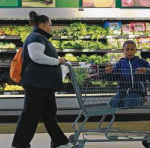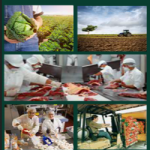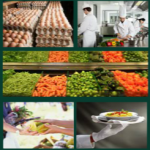I have studied blockchain a little, and can see great utility in its universal un-dilutable universal ledger approach. It is horribly data inefficient, but with incredible strides in memory systems, why not waste all available resources, an IT priority I hate.
Someone came up with a fantastic use for this technology. Food Safety chain problem tracking.
The first food poisoning cases came to light in late March: Eight patrons of fast-food restaurants in New Jersey suffered bloody diarrhea and cramps that sent them rushing to hospitals. More than two months later, one person is dead in California, 75 others have been hospitalized, and federal authorities still don’t know where a nasty strain of E. coli bacteria latched on to romaine lettuce from Yum a, Ariz. Their struggle to trace dozens of supply lines across 32 states, on a paper trail that often might actually be on paper, demonstrates the limits of tracing food by methods rooted in another century.
Food safety advocates and industry insiders say it may be time to borrow the encrypted accounting platform that drives crypto currency: block chain. Blockchain, the encrypted accounting platform, may have helped solve the mystery of the nationwide romaine lettuce E. coli outbreak.
“I often describe that as food trace ability at the speed of thought: As quickly as you can think it, we can know it,” said Frank Yi annas, vice president of food safety for Walmart, which is scaling up an IBM-driven pilot block chain that already includes top suppliers such as Uni lever, Nestlé and Dan one.
Not long ago, Yi annas, who guards the integrity of food in Walmart’s $280 billion grocery empire, would have brushed off the notion of an instantly “knowable” and verifiable food chain as fantasy. He heard about it two years ago, when Walmart was about to open a food safety institute in China, where 10 years ago a baby formula adulteration scandal sickened 54,000 babies.
“Up until that point I only knew that it was the technology behind bit coin,” Yiannas said. “I will tell you I was a bit of a skeptic, just like many people are about the technology.” Block chain, for all its cloak-and dagger associations, is basically a democratized accounting system made possible by advances in data encryption. Rather than storing proprietary data behind traditional security walls, companies contribute encrypted blocks of data to a “distributed” ledger that can be monitored and verified by each farmer, packer, shipper, distributor, wholesaler and retailer of produce. No one can make a change without everyone knowing, and agreeing to it.
“If I want to change something or fudge something on my version of the ledger, I then have to share it with everybody else, and they all have to agree to that,” Yiannas said. “You can’t have two separate sets of books. It’s one set of books that everyone sees.”
As it stands, no one can see the entire path from farm to fork. Each time a food-borne illness breaks out-which tends to happen around 900 times a year-investigators have to work their way backward, one link at a time, from victims to fields, tracing multiple paths across separate companies and sometimes across international borders. This would generate great strides in this nearly unmanageable problem.
“It’s very linear, but the food system as we know is not very linear,” Yiannas said. That linear approach can cost lives and waste billions of dollars in health care costs, lost work hours and trashed food every year, health officials and analysts say. Food borne illnesses can cost the economy $152 billion a year, with tainted produce
responsible for a quarter of that damage, according to a Pew Charitable Trust study.
“To say to consumers that you shouldn’t be consuming romaine lettuce if it came from the Yum a area [a leader in organic farming], and yet that information at the point of consumption or the point of purchase isn’t readily available or obvious to the consumer, then that’s a problem,” said Step hen Ostroff, deputy commissioner for food and veterinary medicine at the U.S. Food and Drug Administration.
Block chain, first developed in the 1990s, was considered some dark art in the world ofcrypto currency in 2010, when Congress passed the Food Safety Modernization Act,the first major overhaul of the nation’s deeply fragmented food safety regulation since the 1930s.
The law required the FDA to identify high-risk foods and require companies to keep better records of them. The agency has yet to write those rules-and they have been further delayed by the Trump administration’s wholesale rollback of regulation. I hope that nobody falls out of their chair from this revelation.
“Seven years after the enactment of FSMA, the FDA has yet to carry out Congress’s mandate to create a list of high-risk foods and issue a proposed rule for enhanced record keeping,” a coalition of food safety advocates said in a letter to the agency recently.
The groups noted that leafy greens were responsible for more cases of E. coli illness than any other produce-a general category that accounted for half or more of the outbreaks of listeria, E. coli and salmonella, and a third of the campylobacter outbreaks reported from 2009 to 2013.
Ostroff said implementing the remaining FSMA regulations “would help, but it wouldn’t necessarily solve the problem” presented by such a broad outbreak.
No one solution will. only cocktails of efforts will better address food safety issues.
Parts of this article taken from an article by BY GEOFFREY MOHAN LOS ANGELES TIMES



